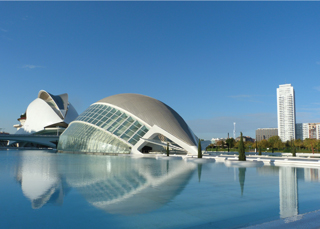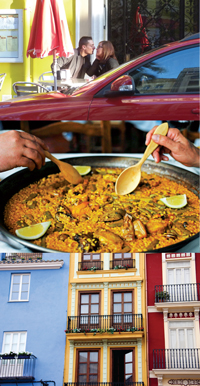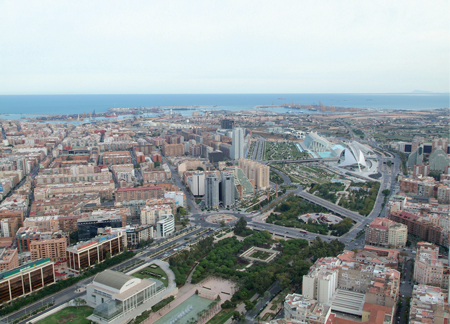If you are heading to Valencia, Spain, here’s our advice: Take along an empty suitcase (the shopping is beyond abundant); stay at least a week (there’s that much to do) and arrive a little bit hungry (the restaurants and cafes are world-class). One more suggestion: If you’re not heading to Valencia, put it on your to-do list. We found this ancient city of 810,000 residents on the Mediterranean coast to be clean and safe yet deeply intriguing and always entertaining.
Credit the Romans in 138 B.C. for founding Valencia; credit today’s Valencians for building a modern museum, where we strolled atop a glass floor and gazed down on those original Roman baths, tombs and even a ward for victims of the plague. Then in 714 A.D. the city was conquered by Muslims and, five centuries later, converted to Christianity by a local king — all of which makes for a rich cultural and artistic heritage.
A mere 54 years ago, the course of Valencia’s history was altered significantly (and magnificently) when, following a major flood, the Turia River was redirected and the city was on its way to becoming Spain’s third largest.
 Where the Turia River once flowed is now Turia Garden, a contiguous stream of parks, promenades and playgrounds that cut a graceful swath through all of the city. Anchoring this three-mile-long greenbelt at one end is BioPark Valencia, a 25-acre zoo designed with barriers that contain the various animals but are invisible to visitors.
Where the Turia River once flowed is now Turia Garden, a contiguous stream of parks, promenades and playgrounds that cut a graceful swath through all of the city. Anchoring this three-mile-long greenbelt at one end is BioPark Valencia, a 25-acre zoo designed with barriers that contain the various animals but are invisible to visitors.
What anchors the other end of Turia Garden is a story unto itself. Our hotel, the very accommodating Primus Valencia, is easy walking distance to the massive and yet visually airy City of Arts and Sciences and was designed by renowned architect and Valencia native Santiago Calatrava. The 86-acre City of Arts and Sciences, or Ciudad de las Artes y las Ciencias, is filled with interesting options for tourists and residents alike. It houses Spain’s largest opera house; a science museum that’s twice the size of the California Academy of Sciences in Golden Gate Park; an aquarium that’s the largest in Europe; an Imax Dome Theater presented architecturally as the “Eye of Wisdom;” a multipurpose center that, among dozens of other attractions, hosts international tennis tournaments and equestrian events; and a promenade that is both an outdoor art gallery and a botanical garden. Bisecting all of the above is the six-lane Calatrava Bridge, completed in 2008, with a spectacular curved mast rising 400 feet in the air.
Most structures within the City of Arts and Sciences appear to float on a veneer of water that reflects their dramatic presence. The complex also includes three restaurants; an underground (literally) nightclub for the city’s chic that springs to life at one in the morning and closes at three-thirty; and parking and transit terminals for the 25 million visitors from all over the world who come to this amazing attraction annually. As two of those 25 million tourists, we considered standout moments visiting the amazing dolphin show at the aquarium, seeing baby chicks come to life at the Museum of Science and catching a fascinating film on the Hubble Space Telescope at the Imax Dome theater. Trust us, Valencia’s City of Arts and Sciences is a modern-day phenomenon that is tourist-friendly in an old-fashioned manner.
 Valencia’s ancient city center, however, is another matter. Its maze of boulevards, streets and alleyways will frustrate the most experienced urban traveler. Again, trust us — no two maps we referred to were the same. The good news is that around every corner lies a surprise. One of ours was wandering into Valencia’s 100-year-old high-ceilinged Central Market, a constantly buzzing mix of sights, sounds, colors and smells where the people are every bit as engaging as the products. “It’s one of the oldest markets in all of Europe,” a local baker told us in slightly accented English. “After a recent renovation, it is even more beautiful than before.”
Valencia’s ancient city center, however, is another matter. Its maze of boulevards, streets and alleyways will frustrate the most experienced urban traveler. Again, trust us — no two maps we referred to were the same. The good news is that around every corner lies a surprise. One of ours was wandering into Valencia’s 100-year-old high-ceilinged Central Market, a constantly buzzing mix of sights, sounds, colors and smells where the people are every bit as engaging as the products. “It’s one of the oldest markets in all of Europe,” a local baker told us in slightly accented English. “After a recent renovation, it is even more beautiful than before.”
We completely agreed. In addition to baked goods, locally harvested vegetables, fruit, meat and fish were displayed with pride in a spacious and immaculate environment that is sure to bring out everyone’s inner chef. Obviously there were pyramids of Valencia oranges, but there were also mushrooms of all shapes and sizes, fresh pineapple and eggplant, live eels and stands offering samples of horchata, the famous health drink favored by Valencians that’s made from water, honey and crushed tiger nuts. In one tiny, tidy booth, a white-haired, white-smocked merchant — glasses at the tip of his nose — sat behind a glass panel using a scalpel to prepare recently caught anchovies for display. He looked more like a jeweler than a seafood salesman.
And if jewelry is your interest, head for Marquese de Dos Aguas, an easy-to-find enclave of upscale shopping, services and cafes in the ageless heart of Valencia. Bvlgari, Hermès, Loewe, Montblanc, Louis Vuitton and Ermenegildo Zegna — they’re all there. We visited Lladró, a boutique where the high-quality porcelain figurines for which the artisans are known — from ballerinas to lovers to Buddha — are presented in a museum-like setting. Little did we know the creative headquarters of Lladró — whose secret formula for porcelain perfection is known only to the Lladró brothers — is located just outside Valencia’s city limits. A Lladró bust of Buddha costs around $450 (including shipping). At the other end of the scale was “Queen of the Nile,” a statuary considerably larger and more intricate piece involving dozens of figures and colors; it was priced at $165,000.
Just blocks away, we viewed an object whose value is inestimable. Within the enormous Cathedral of Valencia — well protected and high atop an altar — sits a chalice many Christian historians believe is the Holy Grail, the cup Christ purportedly used as a drinking vessel at the Last Supper. It has been enshrined in the cathedral since 1437, and, although the Vatican has never authenticated it, Popes John Paul II and Benedict XVI used the chalice in services during their visits to Valencia.
But don’t let such history lead you to think the Gothic-inspired Cathedral of Valencia is just another musty religious shrine. It’s immaculate, well lit and offers engaging self-guided audio tours in several languages. In addition to the (possible) Holy Grail, we were taken with the 15th-century paintings of the martyr San Sebastian’s torturing and an elaborate, two-and-a-half-ton throne made of gold, silver and countless jewels that to this day is carried through Valencia’s streets during religious celebrations.
Another celebration, one of a more hedonistic nature, is the city’s famed Restaurant Week, or Cucina Oberta. To our delight, it was occurring while we were in town. Back near the Central Market, Seu-Xerea, a sleek (zero art on the walls) restaurant, we feasted on paella (which was invented in Valencia) that included sardines, roasted pumpkin, red peppers and caramelized baby onions and was over-the-top delicious. Because of the national tradition of siesta, lunch in Spain does not start buzzing until two in the afternoon. Our subsequent dining experiences involved seafood from the Mediterranean, wines from nearby vineyards and hams raised locally. Two favorite restaurants were Las Graelles, where (we were told) singer Julio Iglesias dines when he’s in town, and A Tu Gusto, a corner cafe amid the apartments opposite the City of Arts and Sciences. All gave the impression that Valencians prefer cuisine that arrives in small portions — but large flavors. The tastes were off the charts.
If you’re getting the impression Valencia is a tourist-friendly destination, you’re spot on. Bilingual guides — we recommend at least one day with one — are available through most hotels; museums and cathedrals have multilingual self-guided audio tours; taxis are both reasonable and ubiquitous; frequently found kiosks rent bicycles for an hour or the day; and a Valencia tourist card gives you discounted fares on city buses that seem to pass by every time you look up. One final suggestion: Never hesitate to hop on a red, open-air Valencia tour bus. Its two routes pass by every attraction the city has to offer; they provide multilingual audio descriptions of what you’re witnessing; and the maps, confusing though they can be, are the best ones available.
Valencia is readily accessible from land (the bullet train from Madrid covers the 200 miles in 90 minutes), sea (the Queen Elizabeth II, The World and other top cruise ships dock at the city’s Royal Juan Carlos I Marina) and air (we flew in from Zurich). Bay Area travelers, note that Valencia hosted the America’s Cup races in 2007 and regularly stages European Formula One races as well the World Motorcycle Championships and the Global Champions Equestrian Tour. In addition, music, fashion, dance, film and religious festivals are constantly on the city’s calendar. Granted, it is the birthplace of paella, but Valencia is cooking up a lot more than rice.


